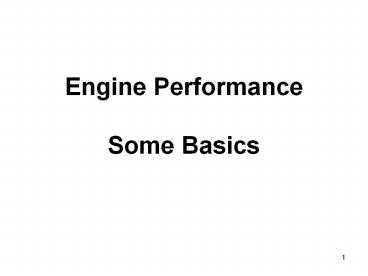Engine Performance Some Basics - PowerPoint PPT Presentation
Title:
Engine Performance Some Basics
Description:
Engine Performance Some Basics – PowerPoint PPT presentation
Number of Views:1769
Avg rating:3.0/5.0
Title: Engine Performance Some Basics
1
Engine PerformanceSome Basics
2
Torque and Power
Torque is measured off the output shaft using a
dynamometer.
The torque exerted by the engine is T
The power delivered by the engine turning at
a speed N and absorbed by the dynamometer is
Note w is the shaft angular velocity in units
rad/s
3
Brake Power
Torque is a measure of an engines ability to do
work and power is the rate at which work is
done Note torque is independent of crank
speed. The term brake power, , is used to
specify that the power is measured at the output
shaft, this is the usable power delivered by the
engine to the load. The brake power is less than
the power generated by the gas in the cylinders
due to mechanical friction and parasitic loads
(oil pump, air conditioner compressor,
supercharger, etc) The power produced in the
cylinder is termed the indicated power, .
4
Indicated Work per Cycle
Given the cylinder pressure data over the
operating cycle of the engine one can calculate
the work done by the gas on the piston. This
data is typically given as P vs V The indicated
work per cycle is given by
Compression Wlt0
Power Wgt0
Intake Wgt0
Exhaust Wlt0
5
Indicated Work per Cycle
Given the cylinder pressure data over the
operating cycle of the engine one can calculate
the work done by the gas on the piston. This
data is typically given as P vs V The indicated
work per cycle is given by
WA gt 0
A
C
WB lt 0
Compression Wlt0
Power Wgt0
Intake Wgt0
Exhaust Wlt0
6
Indicated Power
- Indicated power
- where N crankshaft speed in rev/s
- nR number of crank revolutions per cycle
- 2 for 4-stroke
- 1 for 2-stroke
- Power can be increased by increasing
- the engine size, Vd
- compression ratio, rc
- engine speed, N
7
Mechanical Efficiency
Some of the power generated in the cylinder is
used to overcome engine friction and to pump gas
into and out of the engine. The term friction
power, , is used to describe collectively
these power losses, such that
Friction power can be measured by motoring the
engine. The mechanical efficiency is defined as
8
Mechanical Efficiency, contd
- Mechanical efficiency depends on pumping losses
(throttle position) and - frictional losses (engine design and engine
speed). - Typical values for automobile engines at WOT
are - 90 _at_2000 RPM and 75 _at_ max speed.
- Throttling increases pumping power and thus the
mechanical efficiency - decreases, at idle the mechanical efficiency
approaches zero.
9
Power and Torque versus Engine Speed at WOT
Rated brake power
There is a maximum in the brake power versus
engine speed called the rated brake power
(RBP). At higher speeds brake power decreases as
friction power becomes significant compared to
the indicated power
1 kW 1.341 hp
- There is a maximum in the torque versus
- speed called maximum brake torque (MBT).
- Brake torque drops off
- at lower speeds do to heat losses
- at higher speeds it becomes more difficult to
- ingest a full charge of air.
Max brake torque
10
Indicated Mean Effective Pressure (IMEP)
imep is a fictitious constant pressure that would
produce the same work per cycle if it acted on
the piston during the power stroke.
imep is a better parameter than torque to compare
engines for design and output because it is
independent of engine size, Vd. Brake mean
effective pressure (bmep) is defined as
11
The maximum bmep of a good engine designs is well
established Four stroke engines SI engines
bmep 850-1050 kPa CI engines bmep 700
-900 kPa Turbocharged SI engines bmep
1250 -1700 kPa Turbocharged CI engines bmep
1000 - 1200 kPa Two stroke engines Standard
CI engines comparable bmep to four stroke Large
slow CI engines 1600 kPa Values are at
maximum brake torque and WOT Note, at the rated
(maximum) brake power the bmep is 10 - 15
less Can use above maximum bmep in design
calculations to estimate engine displacement
required to provide a given torque or power at a
specified speed.
12
Maximum BMEP
- The maximum bmep is obtained at WOT at a
particular engine speed - Closing the throttle decreases the bmep
- For a given displacement, a higher maximum bmep
means more torque - For a given torque, a higher maximum bmep means
smaller engine - Higher maximum bmep means higher stresses and
temperatures in the - engine hence shorter engine life, or bulkier
engine. - For the same bmep 2-strokes have almost twice
the power of 4-stroke
13
Typical 1998 Passenger Car Engine Characteristics
Vehicle Engine type Displ. (L) Max Power (hp_at_rpm) Max Torque (lb-ft_at_rpm) BMEP at Max BT (bar) BMEP at Rated BP (bar)
Mazda Protégé LX L4 1.84 122_at_6000 117_at_4000 10.8 9.9
Honda Accord EX L4 2.25 150_at_5700 152_at_4900 11.4 10.4
Mazda Millenia S L4 Turbo 2.26 210_at_5300 210_at_3500 15.9 15.7
BMW 328i L6 2.80 190_at_5300 206_at_3950 12.6 11.5
Ferrari F355 GTS V8 3.50 375_at_8250 268_at_6000 13.1 11.6
Ferrari 456 GT V12 5.47 436_at_6250 398_at_4500 12.4 11.4
Lamborghini Diablo VT V12 5.71 492_at_7000 427_at_5200 12.7 11.0































